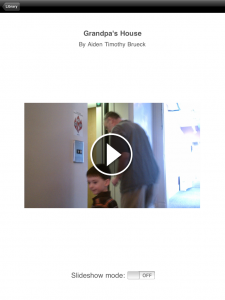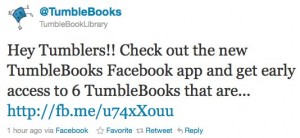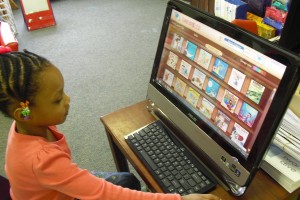
e-Books are becoming increasingly common in our society. Children and adults can read e-Books easily using devices such as the Kindle, Nook, iPods, iPads, iPhones, and computers. The speed at which e-Books are adapted into routine use could be accelerated even faster as communication technologies such as Wi-Fi and smartphones become more common in people’s daily lives.
So, then what does this mean in regards to e-Book reading from the perspective of e-Book pedagogy in early childhood classrooms? What do we know about the quality of current e-Books that many children are reading? During this presentation, we will briefly explain an e-Book instructional model in early literacy, and then we will focus on the issue of developing an e-Book quality-rating tool.
Read the rest of this entry…
none
This past week I had the privilege to present some of my e-Book research with my colleague, BK You from the Southwest Institute for Families, at the inaugural Early Education and Technology for Children Conference in Salt Lake City, Utah. This unique event was sponsored by the Waterford Institute and featured well-known speakers such as Dr. Grover J. “Russ” Whitehurst, Dr. Marilyn Jager Adams and Dr. John Dexter Fletcher, just to name a few.
Read the rest of this entry…
one
 As IEAR app reviewers, we sometimes stumble across an app that just oozes of potential but isn’t there quite yet. With a $14.99 price tag, Pictello, from AssistiveWare packs quite a punch with its unique opportunity to create and publish visual stories. However, IEAR app reviewers can’t help but notice there are some critical features that are missing from the app at this time. Meg Wilson (@ipodsibilities) and Jeremy Brueck (@brueckj23) share their educational insights into the positive features of the app, provide possible areas of classroom application, share their Pictello story codes and point out some places where they hope to see Pictello grow in future releases and updates.
As IEAR app reviewers, we sometimes stumble across an app that just oozes of potential but isn’t there quite yet. With a $14.99 price tag, Pictello, from AssistiveWare packs quite a punch with its unique opportunity to create and publish visual stories. However, IEAR app reviewers can’t help but notice there are some critical features that are missing from the app at this time. Meg Wilson (@ipodsibilities) and Jeremy Brueck (@brueckj23) share their educational insights into the positive features of the app, provide possible areas of classroom application, share their Pictello story codes and point out some places where they hope to see Pictello grow in future releases and updates.
Read the rest of this entry…
none
TumbleBooks Library, a collection of e-books suitable for children in pre-kindergarten to grade twelve, has recently released a Facebook app. From @TumbleBooks:

As of February 25, 2011, you can access TumbleBooks via their classic browser-based model, by purchasing and downloading mobile apps and now through Facebook. A quick look at this free app reveals:
- Access eText in the following formats: Audiobooks, EBooks, Read Alongs and TumbleBooks.
- Sort by Title and Author.
- Preloaded library of a variety of eBooks.
- Ability to SHOP and add new titles to the MY SHELF section of the app.
- Post reviews, comments and recommends to your Facebook wall.
- Invite your Facebook friends to the app.
Read the rest of this post at EdReach.us
none
e-Books will likely be a part of future early childhood classrooms, and in light of the thin evidence base on their role in curriculum and instruction, we undertook a formative study to investigate what e-book pedagogy for early literacy might look like in the early childhood classroom [1]. We approached our research from a design perspective—much like an engineer—creating a prototype model for implementation in the classroom and testing it to begin a winnowing process that informs the educational design (e-books in preschool for purposes of early literacy instruction) and identifies design features that are feasible and preferable in an instructional model [2, 3].
At this early stage of prototype creation, we conceptualized an e-book instructional model that was purposefully under-specified to allow a wide-angle view of what it takes and what happens when e-book technology is inserted into the preschool classroom. The model consists of four components grounded in e-book studies [4] and the knowledge base on early literacy instruction for young children [5]:
- The e-book as a technology-mediated environment
- The physical place of e-book reading in the classroom
- Engagement in e-book reading for small groups and individuals
- Explicit instruction using e-books
Our research objectives were to observe, define the salient attributes and rate the functioning of each component in situ toward the goal of framing a model for replication and further testing. To this purpose we employed a qualitative approach that focused on sorting, clustering and aggregating observational data to derive quality indicators and design features.
The following is a brief overview of some of the data collected during Phase 2 of our 2010-2011 study.
one
I’m headed to Philadelphia later this week to attend the EduCon 2.3 conference. This will be my second trip to SLA, and I am every bit as excited to go back as I was to attend the first time. The main difference between this year and last is that I have decided to add my voice to the conversation as a presenter. I’m honored to be presenting amongst some of the great thinkers in our profession. I’m also humbled by the opportunity to learn along with many of them on a daily basis.
I will be facilitating a discussion around a topic that is very important to me, e-Books. More specifically, I hope to explore how, why and when e-Books should be included as part of the instructional process in the early elementary classroom with an eye towards developing an instructional model that could be used in Pre-K and Kindergarten classrooms across the globe.

Read the rest of this entry…
none

As part of the Akron Ready Steps program, I am currently engaged in a study of an e-book instructional model that integrates the e-book into the preschool classroom. This is a four phase study that will last the entire school year. We recently wrapped up Phase 1 of the study and debriefed our teachers on a number of aspects of the instructional model. After an initial read through, I am particularly intrigued by their comments on what they liked about the eBook shared reading experience. A short excerpt:
Mrs. Brodie
I like the computer. The monitor is large and I like the touch screen. The children like the e-book experience and it is a chance to share a book with a small group of children. I think it is good for the children to hear different voices read the books. I sometimes am able to get a hard copy of an e-book. The children really like looking at the e-book and then the hard copy or vice versa.
Mrs. Campbell
The children love hearing the books read. The readers’ voices really make the book. The children like being at the computer and turning the pages. The children also like the animation in some of the books.
Ms. Sowers
I like working with the small groups in the e-book experience. I like being able to choose between automatic and manual. I liked many of the narrators and realized that the quality of the narration and graphics is what keeps the children’s attention. I like being able to push the pause button on the book so that I can talk with the children before moving on. The pacing of most of the books keep even the three year olds engaged. Some of the graphics are really colorful. I like the words highlighted as they are being read. It helps keep the children’s attention on the words.
Mrs. Taylor
I like the interaction of the children with the book and with me. I like doing the e-book with a small group of children and being able to stop the book and review vocabulary words or talk about a subject. I like the animated voices. It keeps the children interested. I am trying to work on being more animated when I am reading a book to children. The children like the animated voices. I like that the children can push the page turner button when it is flashing. I like the highlighting of words during the reading.
none
I watched the #oneweek unveil at this afternoon on Ustream. Turns out the team assembled at George Mason University built a WordPress plugin that allows you to create custom eBooks from your blog posts and/or external RSS feeds. Projects can be assembled through a drag-and-drop interface. Publish formats currently include ePub, PDF, TEI and RTF.
From the Anthologize blog,
Use the power of WordPress to transform online content into an electronic book.
Anthologize is a free, open-source, plugin that transforms WordPress 3.0 into a platform for publishing electronic texts. Grab posts from your WordPress blog, import feeds from external sites, or create new content directly within Anthologize. Then outline, order, and edit your work, crafting it into a single volume for export in several formats, including—in this release—PDF, ePUB, TEI.
Please note that Anthologize cannot be installed on blogs hosted at WordPress.com.
Read the rest of this entry…
none






